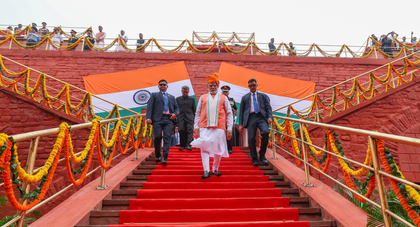Self-reliance, sovereignty and silicon, PM Modi’s I-Day blueprint
By IANS | Updated: August 15, 2025 13:20 IST2025-08-15T13:12:39+5:302025-08-15T13:20:00+5:30
New Delhi, Aug 15 Prime Minister Narendra Modi’s 103-minute address from the Red Fort on the 79th Independence ...

Self-reliance, sovereignty and silicon, PM Modi’s I-Day blueprint
New Delhi, Aug 15 Prime Minister Narendra Modi’s 103-minute address from the Red Fort on the 79th Independence Day marked a watershed moment in India’s political communication -- not only for its record-breaking length but for its sweeping articulation of a self-reliant, strategically autonomous, and technologically empowered nation.
Framed as a roadmap to a Viksit Bharat by 2047, the speech blended policy announcements with ideological clarity, underscoring India’s transformation from dependence to global confidence.
PM Modi’s assertion that “India will no longer accept nuclear blackmail” came in the context of Operation Sindoor -- a retaliatory strike following the Pahalgam attack -- executed entirely with indigenous weaponry.
His remarks on the Indus Waters Treaty -- “blood and water will not flow together” -- signalled a decisive shift in India’s strategic posture, rejecting historical compromises and reaffirming national sovereignty.
These declarations were not isolated; they formed part of a broader narrative of Atmanirbhar Bharat, where self-reliance is defined not merely by trade balances but by technological and institutional capability.
Among the most ambitious announcements was the rollout of India’s first Made in India semiconductor chip by year-end, alongside the opening of the nuclear sector to private players.
PM Modi emphasised that self-reliance must extend to jet engines, social media platforms, fertilisers, and pharmaceuticals.
The National Critical Minerals Mission and the Deepwater Exploration Mission were presented as foundational steps toward securing energy and industrial autonomy, with 1,200 mineral sites under exploration and offshore energy resources being tapped to reduce foreign fuel dependence.
The launch of Mission Sudarshan Chakra -- aimed at developing advanced weapon systems -- and the planned expansion of a nationwide security shield by 2035 reinforced India’s defence preparedness.
PM Modi also announced a Task Force for “Next-Generation Economic Reforms”, building on the repeal of over 40,000 compliances and 1,500 outdated laws, with GST (goods and services tax) reforms promised by Diwali to ease burdens on MSMEs and consumers.
Youth empowerment took centre stage with the PM Viksit Bharat Rojgar Yojana, a Rs one lakh crore employment scheme targeting 3.5 crore young Indians.
In the agricultural sector, the “PM Dhanya Dhanya Krishi Yojana” was launched for 100 backward districts, complementing existing farmer support programmes.
PM Modi also announced the High-Powered Demography Mission to safeguard national integrity against illegal infiltration.
From space innovation to pharmaceutical leadership, the Prime Minister’s address was a call to action -- urging citizens to build, innovate, and invest in India’s future.
As the nation moves toward its centenary of independence, PM Modi’s speech laid out a vision where self-reliance is not a slogan but a structural transformation.
Disclaimer: This post has been auto-published from an agency feed without any modifications to the text and has not been reviewed by an editor
Open in app